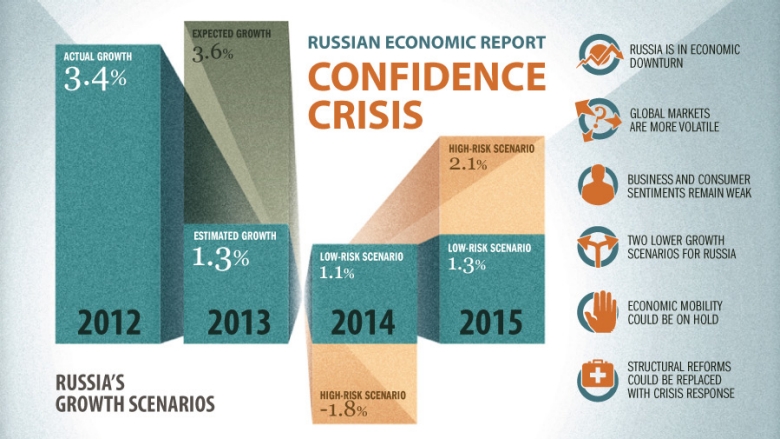How did Russia’s economy fare in the past year?
The economy expanded at an estimated 1.3 percent in 2013, well below the projected rate of 3.6 percent.
The ruble came under increasing pressure, triggered by the ongoing deterioration of the current account and by higher volatility in capital outflows.
Frail domestic demand dragged the Russian economy close to stagnation.
Lack of growth-supporting structural reforms and decreasing profit margins weighted heavily on business sentiments and pushed down industrial and investment activities.
The contribution of fixed investment to GDP growth turned negative in 2013, compared to 1.4 percent in 2012.
Consumption remained the main growth driver, supported by fast credit and wage growth, yet its pace of expansion more than halved compared to 2012.
External demand recovered as expected in the second half of 2013, while exports grew strongly.
What is the economic outlook for Russia going forward?
Weaker growth prospects and stabilizing consumption at a lower rate decrease the economic mobility outlook. Recent events around the Crimea crisis have compounded the lingering confidence problem and exposed the economic weaknesses of the economic growth model, which is based on large investment projects, continued increases in public wages and transfers.
Given the higher risk environment -- since political uncertainties around the Crimea crisis in early March 2014 led to an increase in market volatility, the World Bank developed two alternative scenarios for Russia’s 2014-2015 growth outlook.
- The low-risk scenario assumes a limited and short-lived impact of the Crimea crisis and projects growth to slow to 1.1 percent in 2014 and slightly picking up to 1.3 percent in 2015.
- The high-risk scenario assumes a more severe shock to economic and investment activities if the geopolitical situation worsens and projects a contraction in output of 1.8 percent for 2014.
Impact on economic mobility and continued middle-class formation in Russia:
- Consumption growth is forecast to decrease to about 2 percent for 2014-2015 in the low-risk scenario, compared to 3.4 percent in 2013 and 6.9 percent in 2012
Russia’s long-term outlook will depend on a sustained positive shift in investors’ and consumers’ confidence.
- Structural reforms will need to be started in the coming years.
- Inefficiencies in factor allocation across the economy will need to be addressed, so that larger private investment is attracted in a sustained manner and on a larger scale.
- The quality of regulatory and market institutions will have to improve, so that rules are implemented evenly.

